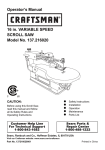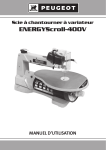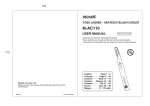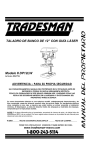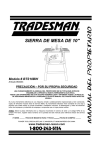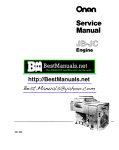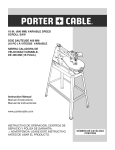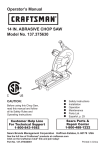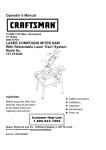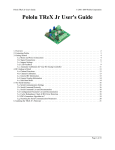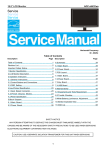Download Scroll saw
Transcript
Sierra caladora de 16 ” (406.4 mm) Scroll saw KN SS-162 KN SS-162 INDEX Specifications 2 General safety rules for power tools 2 Additional safety rules for scroll saw 3 Unpacking 4 Glossary of terms for woodworking 4 Motor specifications and electrical requirements 5 Getting to know your scroll saw 6 Assembly Installing dust blower system 7 Installing blade guard 7 Removing and installing blades 3 Adjustment To align the bevel indicator 10 Basic scroll saw operation 11 Maintenance 12 Trouble shooting 12 List of parts 13 Graph of parts 13 SPECIFICATIONS Depth of 90º cut: 2” (50.8 mm) Depth of 45º cut: 1” (25.4 mm) Motor: 1/10 H.P. 120 V. 60 Hz. Throat: 16” (406.4 mm) Table size: 10” x 17” (254 x 432 mm) Table tilting: 45º (L / izq. ) Machine dimentions: Weight: net/gross: Blade lenght: 5” (127 mm) Stroke per minute: Stroke: 3/4” (19 mm) 1,725 23-3/8” x 12-1/2” x 13-3/8” (594 x 317.5 x 340 mm) large - width - height 21/23 Kgs. GENERAL SAFEW RULES FOR POWER TOOLS: WARNING: When using electric tools the following basic safety precautions should always be followed to reduce the risk sf fire, eEectric shock and personal injury. 7. USE FUGHT TOOL. Don’t force tool or attachment to do a job for which it was not designed. Do not use tools for purposes not intends; for example do not use circular saws to cut tree limbs or logs. PLEASE READ ALL THESE INSTRUCTIONS BEFORE ATTEMPTING TO OPERATE THIS PRODUCT. 1. KEEP WORK AREA CLEAN. Cluttered areas and benches invite accidents. 8. WEAR PROPER APPAREL. Do not wear loose clothing, gloves, neckties, rings, bracelet, or others jewellery, which may get caught in moving, parts. No slip footwear is recommended. Wear protective hair covering to contain long hair. Roll long sleeves above elbows. 2. DON’T USE IN DANGEROUS ENVIRONMENT. Do not use power tools in damp or wet location, or expose them to rain. Do not operate them in an area with flammable liquids or gases. Keep work area well lighted. 3. GUAIRD AGAINST ELECTRIC SHOCK. Avoid body contact with earthed or grounded surfaces. 9. PLWAYS USE SAFETY. GOGGLES Everyday glasses only have impact resistant lenses, they are NOT safety glasses. Also use face or dust mask if butting operation is dusty. 4, KEEP CHILDREN AWAY. Ml visitors should be kept at a safe distance from work area. Do not let visitors touch the tool or extension cord. 10. CONNECT DUS1 EXTRACTION EQUIPMENT. If devices are provided for connection of dust extraction and collecting facilities ensure these are connected and properly used. 5. MAKE WORKSHOP CHILD PROOF. Lock access of your workshop. When not in use, tools should be stored in a dry locked up place, out of reach of children. 11. DO NOT ABUSE THE CORD. Do not use cord to disconnect during operation. Never yank the cord to disconnect it from the socket Keep the cord sway heat, oil and sharp edges. 6. DON’T FORCE TOOL. It will do the job better and safer at the rate for which it was designed. 1 12. SECIJRE WORK. Use clamps or a vice to hold work when practical. It is safer than using your hand and it frees both hands to operate tool. 20. CHECK DAMAGED PARTS. Before further use of the tool, a guard or other part that is damaged should be carefully checked to determine that it will operate properly and perform its intended function check for alignment of moving parts, binding of moving parts, breakage of parts, mounting, and any other conditions that may affect its operation. A guard or other part that is damaged should be properly repaired and replaced. by an authorized service centre. Unless otherwise indicated in ~is instruction manual. Have defective switches replace by authorized service centre. Do not use tool if switch does not turn it on and off. 13. DON’T OVERREACH. Keep proper footing and balance at all times. 14. MAINTAIN TOOL WITH CARE. Keep tool sharp and clean for best and safest performance. Follow instructions for lubrication and changing accessories. Inspect tool cords periodically and if damages have repaired by an authorized service facility. Inspect extension cords periodically and replace if damaged. Keep handles dry, clean and free from oil and grease. 21. USE RECOMMENDED ACCESSORIE5. Consult the owner’s manual for recommended accessories. The use of improper accessories may cause risk of injury to persons. 15. DISCONNECT TOOLS before servicing; when changing accessories, such as blades, bits, cutters and the like. 22. HAVE YOUR TOOL REPAIRED BY A QUALIFIED PERSON. This electric tool is in accordance with the relevant safety rules. Repairs should only be carried out by qualified in considerable danger to the user. 16. REMOVE ADJUSTING KEYS AND WRENCHES. Form habit of checking to see that keys and adjusting wrenches are removed from tool before turning it on. 23. SAVE THESE INSTRUCTlONS. Read these instructions and save these instructions for operating guide. 17. AVOID UNINTENTIONAL STARTING. Ensure switch is off when plugging in. 24. KEEP GUARDS IN PLACE, and in working order. 18. USE PROPER EXTENSION CORD. Make sure your extension cord is in good condition. When using an extension cord, be sure to use one heavy enough to carry the current your product will draw. An undersize cord will cause a drop in line Voltage resulting in loss of power and overheating. When tool is used outdoors, use only extension cords intended for outdoor use and so marked. 25. NEVER STAND ON TOOL. Serious injury could occur if the tool is tipped or it cuffing tool is unintentionally contacted. 26. DIRECTION OF FEED. Feed work into a blade or cutter against the direction of rotation of the blade or cutter only. 27. NEVER LEAVE TOOL RUNNING UNATTENTED. TURN POWER OFF. Don’t leave tool until it comes to a complete stop. 19. ALWAYS KEEP ALERT. Do not let familiarity gained from frequent use of your tool cause a careless mistake. Always remember that a careless fraction of a second is sufficient to inflict severe injury. Watch what you are doing: Use common sense. Do not operate tool when you are tired. 28. THINK SAFETY. Safety is a combination of common sense and alertness whenever the tool is in operation. ADDITIONAL SAFETY RULES FOR SCROLL SAW: Safety is a combination of operator common sense and alertness at all times when the scroll saw is being used. 5. Avoid awkward hand positions where a sudden slip could cause a hand to move into the blade. WARNING: FOR YOUR OWN SAFETY, DO NOT ATTEMPT TO OPERATE YOUR SCROLL SAW UNTIL IT IS COMPLETELY ASSEMBLED AND INSTALLED AND ACCORDING TO THE INSTRUCTIONS...AND UNTIL YOU READ AND UNDERSTAND THE FOLLOWING: 6. Never turn your scroll saw “ON” before clearing the table of all objects (tools, Scraps of wood, etc.,) except for the work piece and related feed or support devices for the operation planned. 1. Your scroll saw must be bolted securely to a stand or work bench. In addition, if there is any tendency for the scroll saw to move during certain operations, bolt your scroll saw stand or workbench to the floor. 7. Make sure the blade teeth point downward toward the table. 8. Always adjust blade tension correctly. 9. When cutting a large piece of material, make sure it is supported at table height. 2. This scroll saw is intended for indoor use only. 10. Hold the work firmly against the table. 3. Wear safety goggles that comply with ANSI Z87.1 and a face shield if operation is dusty, Wear earplugs or muffs during extended periods of operation. Do not wear gloves or roll long sleeves above the elbow. 11. Do not feed the material too fast while cutting. Only feed the material fast enough so that the blade will cut. Keep fingers away from the blade. 4. Do not cut pieces of material too small to hold by hand. 2 12. Use caution when cutting off material that is irregular in cross section that could pinch the blade before the cut is completed. A piece of molding for example must lay flat on the table and not be permitted to rock while being cut. 17. Turn was “OFF” and remove plug from power supply outlet before installing or removing an accessory or attachment. 18. Should any part of this scroll saw be missing, bent or fail in any way, or any electrical component fail to perform properly, shut off power switch and remove plug from power supply outlet, Replace damaged, missing, and/or failed parts before resuming operation. 13. Use caution when cL1ting off round material such as dowel rods, or tubing. they have a tendency to roll while being cut causing the blade to “bite’’. 14. When backing the blade out of the workpiece, the blade may bind in the kerf (cut).... this is usually caused by sawdust clogging up the kerf. If this happens: Turn off the scroll saw.... remove plug from power source outlet... wedge open the kerf... back, the blade out of the work piece. 15. Never leave the scroll saw work area with the power on, before the machine has come to a complete stop. 19. Think Safety. Safety is a combination of operator common sense and alertness whenever the scroll saw is in operation. WARNING: ALWAYS KEEP ALERT. DO NOT ALLOW FAMILIARITY (GAINED FROM FREQUENT USE OF YOUR SCROLL SAW) TO CAUSE A CARELESS MISTAKE ALWAYS REMEMBER THAT A CARELESS FRACTION OF A SECOND IS SUFFICIENT TO INFLICT SEVERE INJURY. 16. Do not perform layout, assembly, or setup work on the table while the cutting tool is operating. UNPACKING AND CHECKING CONTENTS WARNING For your own safety, never connect plug to power source outlet until all assembly Steps are completed, and you have read and understood the safety and operational instructions. CAUTION: Never lift this saw by the arm which holds the blade or damage will occur to your saw. TABLE OF LOOSE PARTS A. SCROLL SAW B. OWNER’S MANUAL C. LOOSE PARTS BAG (including) 1. Blade guard assembly Do not lift saw by this arm Lift here Lift here 3 2. Pin end plain end blade 3. T wrench 4. Dust blower assembly GLOSSARY OF TERMS FOR WOODWORKING 1. Kerf the slot cut by the blade. 4. Blade Tooth Set the distance that the edge of the saw blade tooths is bent (on set) outward from the side of the blade. 2. Leading Edge the edge of the workpiece, which pushed into the blade first 5. Trailing Edge the work piece edge last cut by the saw blade. 3. Saw blade Path the area of the workpiece directly in line with and moving toward the saw blade edge. 6. Work Piece the Item on which the cutting operations is being performed. Leading Edge Kerf Workpiece Saw blade Path Blade Toofth Set Trailing Edge MOTOR SPECIFICATIONS AND ELECTRICAL REQUIREMENTS This plug requires a mating 3 conductor grounded type outlet as shown. WARNING: Rating, power supply cord with plug and grounded outlet indicated hereby are according to electrical regulations of United States and Canada. For other countries, they may be different. Therefore, for the actual electrical rating please see marking on this machine, however for any details of the information on power supply cord with plug and the grounded outlet, please consult a qualified electrical technician. WARNING: DO NOT PERMIT FINGEIRS TO TOUCH THE TERMINALS OF PLUGS WHEN INSTALLING OR REMOVING THE PLUG TO OR FROM THE OUTLET. 3 PRONG PLUG This machine is equipped with a one-speed switch for greater versatility. It is wired for operation on 110 120 volts, 60 Hz, alternating current. CONNECTING TO POWER SUPPLY OUTLET If power cord is worn or cut, or damaged in any way, have it replaced immediately. GROUNDING PRONG WARNING Improper grounding can shock, burn or electrocute. Grounding of this tool is necessary while in use to protect you from electric shock or electrocution. This tool is equipped with an approved three-conductor cord and three prong grounding type plug to fit the proper grounding type receptacle. Do not remove grounding prong from the three-prong grounding type plug. The green (or green and yellow) conductor in the cord is the grounding wire. Never connect the green (or green and yellow) wire to a live terminal. 4 ALWAYS USE A GROUNDED OUTLET Plug power cord into an 110 120V properly grounded type outlet. If the outlet you are planning to use for this power tool is of the 2-prong type. DO NOT REMOVE OR ALTER THE GROUNDING PRONG IN ANY MANNER. Use an adapter as shown below and always connect the grounding lug to known ground. It is recommended that you have a qualified electrician replace the TWO-prong outlet with a properly grounded THREE-prong outlet. MAKE SURE GROUNDING LUG THIS IS CONNECTED TO A KNOWN GROUND SCREW WARNING: TIHE GREEN GROUNDING LUG EXTENDING FROM THE ADAPTER MUST E3E CONNECTED TO A PERMANENT GROUND SUCH AS TO A PROPEFILY GROUNDED OUTLET BOX NOT ALL OUTLET BOXED ARE PROPERLY GROUNDED. If you are not sure that your outlet box is properly grounded have it checked by a qualified electrician. NOTE: The adapter illustrated is for use only if you already have s properly grounded 2 prong receptacle. Adapter is not allowed in Canada by the Canadian Electrical Code. The use of any extension cord will cause some loss of power. Use only 3 wire extension cords, which have 3‑prong grounding type plugs, and 3 pole receptacles, which accept the tools plug. Extension Cord Length 3 PRONG PLUG ADAPTER Wire Size A. W. G. Up to 1000 Ft. 16 100 200 Ft. 14 200 400 Ft. 10 2 PRONG RECEPTACLE GETTING TO KNOW YOUR SCROLL SAW 1.QUICK RELEASE AND TENSION LEVER: Allows you to quickly loosen, or tighten the blade to its original tension with lever action. QUICK RELEASE AND TENSION LEVER 2.BLADE GUARD: Protects hands from blade contact. 3.BLADEHOLDER: Retain and position blade. 4.SAWDUSTBLOWER: Keeps workpiece clean for more accurate scroll cuts. For best results, always direct air flow from blower tube at blade and workplace. BLADE GUARD 5.0N / OFF SWITCH: Has holes provided by the switch for a lock. This feature is intended to prevent unauthorized and possible hazardous use by children and others. To turn saw on push switch to the “on” position, to turn saw off push switch to “off” position. BLADEHOLDER DROP FOOT 6.BEVELSCALES: Shows degree blade is tilted for bevel cutting. SAWDUST BLOWER 7.BLADE STORAGE CASE: Your scroll saw is equipped with a blade storage area located on the side of the saw. The blade storage area conveniently stores the blade adapter, allen wrenches and both pin and plain end blades. BLADE STORAGE CASE BEVELSCALES 8. DROP FOOT: Prevents your workpiece from raising up from the table. 5 0N / OFF SWITCH ASSEMBLY Mounting Scroll Saw To Workbench 4. If mounting to a workbench, holes should be drilled through supporting surface of the workbench using dimensions. 1. When mounting the saw to a workbench a solid wood bench is preferred over a plywood bench where noise and vibration will be more noticeable. Installing Dust Blower System 1. Connect one end of the PVC Hose to the Brass Tube and the other end to the of the Bellows Seat. 2. Hardware to mount this saw to a workbench is NOT supplied with the saw. However, we recommend the hardware used be no smaller than the following. 2. Position and tighten the Brass Tube with Clamp and Knob. 3. For best result, the Brass Tube should be adjusted to direct air bolt at blade and workpiece. Quantity Description 4 Hex. Head Screws, 1/4 20 x Length Required 4 Flat Washers, 9/32 I.D. Installing Blade Guard 4 Lock washer, g/321.D. 8 Hex Nuts, 1/4 20 1. Locate the blade guard and carefully install it onto the saw as shown the blade guard to frame by bolt washer and Knob. NOTE: When cutting at angles, the drop foot can be tilted so it’s parallel to the table and rests flat against the workpiece. To tilt drop foot, loosen screw, tilt toot so it’s parallel to table and securely tighten screw. The drop foot should always be lowered until it just rests on top of the workpiece. 3. A soft foam pad to place between your scroll saw and workbench is NOT supplied with the saw. However, we highly recommend the use of such a pad (24”x1 2”x1/2”) to reduce noise and vibration. GUARD ASSEMBLY PVC HOSE FRONT OF SCROLL SAW KNOB DROP FOOT BRASS TUBE 6 REMOVING AND INSTALLING BLADES a 2 Installing Blade WARNING: To avoid injury from accidental starting I always turn the switch off (“o”) and remove power cord plug from power source before removing or replacing the blade. 1. To install the blade, insert the Blade through the Access Hole in the table. (Fig 3) NOTE: In order to avoid uncontrollable lifting of the workpiece, the teeth of the blade should always point downward. A. Plain End Blade 2. Insert the Blade into the lower Blade Holder slot then tighten set screw. (Fig 4) a 1 Removing Blade 1. To remove the Blade, Loosen tension on blade by first lifting up the Quick Release Tension lever. (Fig 1) 3. Insert the other end of Blade into the upper Blade Holder slot and then tighten set screw. (Fig 4) 2. Loosen the upper set screw on the side of the upper Blade Holder. (Fig 2) Slightly downward pressure against the upper arm maybe helpful when installing the Blade into upper Blade Holder. (Fig 5) 3. Loose the lower set screw by inserting the T-¬Wrench through the Access Hole on the side of the upper Blade Holder. (Fig 2) 4. Tighten the tension on the Blade by lowering the Quick Tension Lever and turning the Lever clockwise. Check the tensions on Blade, if too loose, turn Lever clockwise; if too tight, turn Lever counterclockwise. (Fig-6) 4. Remove blade from the upper and lower Blade Holders by pulling forward and lifting the Blade through the Access Hole in the table. (Fig 3) NOTE: If the blade is over tightened, the Lever is difficult to be lowered. RELEASE TENSION SLIGHT PRESSURE HERE QUICK RELEASE TENSON LEVER TIGHTEN LOOSEN (Flg. 4) SET SCREW (Fig. 1) (Fig. 5) (Fig. 2) QUICK RELEASE TENSON LEVER LOOSEN TIGHTEN ACCESS HOLE (Flg. 6) (Fig. 3) 7 B. Pin End Blade 2 Installin0 the Blade Note: When installing Pin-End Blades, the set screws located on the upper and lower Blade Holders should not be over or under tightened. 1. Install the Blade by inserting one end of the Blade through the Access Hole in the table and hook the blade pin in the pin recess in the lower Blade Holder. (Fig 2) The slot must be slightly wider than the thickness of the Blade. After the Blade is installed, me blade tension mechanism will keep the Pin End Blade in place. 2. Check to see that the pins are properly located in the upper and lower Blade Holders. 3. To tension Blade, lower the Quick Release Tension Lever. Check tension on Blade, if too tight, turn Lever counteclockwise. (Fig-4) b 1 Removing the Blade 1. To remove the Blade, loosen tension on blade by first lifting up the Quick Release Tension Lever. (Fig 1) Note: H the Blade is over tensioned, the Lever is difficult to be lowered. 2. Remove Blade from the upper and lower Blade Holder. (Fig 2) Slightly downward pressure against the upper arm may be helpful when removing Blade from the upper Blade Holder. (Fig 3) RELEASE TENSION QUICK RELEASE TENSION LEVER TIGHTEN LOOSEN PIN RECESS (Fig. 2) (Fig. 1) QUICK RELEASE TENSION LEVER SLIGHT PRESSURE HERE LOOSEN TIGHTEN PIN RECESS (Fig. 4) (Fig. 3) 8 ADJUSTMENT TO ALIGN THE BEVEL INDICATOR 1. Loosen the bevel lock handle and move the table until it is approximately perpendicular or at a right angle, to the blade. 2. Use a small square to set the table at 90 degrees to the blade. If there is too much space between the square and the blade the table must be adjusted. SQUARE 3. When the space between the square and blade is minimal tighten the bevel lock handle. The table should now be approximately 90 degrees to the blade. 4. Loosen the screw holding the bevel scale pointer and adjust pointer to O degree. Tighten screw. Then adjust 0 degree set screw under the table. SCALE POINTER Remember the bevel scale is a convenient guide but should not be relied upon for precision. Make practice cuts in scrap wood to determine if your angle settings are correct. Adjust the table as required. NOTE: AVOID SETTING THE EDGE OF THE TABLE AGAINST TOP OF MOTOR, WHICH COULD CAUSE NOISE WHEN THE SAW IS USED. BEVEL LOCK HANDLE SET SCREW BASIC SCROLL SAW OPERATION A SCROLL SAW IS BASICALLY A “CURVE CUTTING” MA- INSIDE CUTTING CHINE. IT CAN ALSO BE USED FOR STRAIGIIT LINE CUTWARNING: TO AVOID INJURY FROM ACCIDENTAL TING OPERATIONS SUCH AS CUTTING, RIPPING, BEVSTARTING, ALWAYS TURN SWITCH “OFF” AND REELING, REFER FIG. 9 (BEVELING), FIG. 10 (SCROLLING). MOVE SWITCH KEY BEFORE REMOVING OR REPLACPLEASE READ AND UNDERSTAND THE FOLLOWING ITEMS ING THE BLADE. ABOUT YOUR SCROLL SAW BEFORE ATTEMPTING TO USE THE SAW. The scroll saw has the capability of inside cutting, to perform 1. The saw does not cut wood by itself. You allow the saw to an inside cut, proceed as follows: cut wood by guiding the wood into the blade as it moves. 1. Drill a ¼ inch hole in the board you will use to make inside 2. The blade teeth cut wood ONLY on the down stroke. cutting. 3. You must guide the wood into the blade slowly because the 2. Reiease tension knob, remove blade. teeth of the blade are very small and they can only remove wood when they are on the down stroke. 3. Place the board on the saw table with the hole in the board 4. There is a learning curve for each person who wants to use over the access hole in the table. this saw. During that period of time it is expected that some 4. Install blade through hole in board and adjust blade tenblades will break until you learn how to use the saw and re- sion. ceive the greatest benefit from the blades. 5. When finished making the interior scroll cuts simply re5. Best results are achieved when cutting wood less than one move the blade from the blade holder, and remove the board inch thick form the table. 6. When cutting wood thicker than one inch the user must guide the wood very’ very slowly into the blade and take extra care not to bend or twist the blade while cutting in order to maximize blade Iife. 7. Teeth on scroll saw blades wear out and as such must be replaced frequently for best cutting results. Scroll saw blades generally stay sharp for 1/2 hour or 2 hours of cutting. 8. To get accurate cuts be prepared to compensate for the blades tendency to follow the wood grain as you are cutting. 9. This scroll saw is intended to cut wood or wood products. For cutting precious and non ferrous metals, these must be used at very slow speeds. They perform well on machines that have variable speed capability and should be lubricated with beeswax. 9 Trouble Shooting WARNING: For your own safety, turn switch “off” and remove plug from power source outlet before trouble shooting your scroll saw. PROBLEM PROBLEM CAUSE REMEDY SUGGESTED Breaking Blades 1. Wrong tension 2. Over working blades. 3. Wrong blade application. 4. Twisting blade in wood. 1. Adjust blade tension. 2. Reduce feed rate. 3. Use narrow blades. 4. Avoid side pressure on blade. Motor will not run 1. Defective cord or plug. 2. Defective motor. 1. Replace defective parts before using saw again. 2. Consult Service Center. Any attempt to repair this motor may create a HAZARD unless repair is done by a qualified service technician. 1. See mounting instructions in this manual for proper mounting technique. 2. The heavier your work bench is the less vibration will occur. A plywood workbench will not be as a good work surface as the same size solid lumber. Use common sense in choosing a mountioning surface. 3. Tighten table lock knob. 4. Tighten motor mounting screws. Vibration NOTE: There will always be some vibration present when the saw is running because of the motor operation Blade Run out Blade not in line with arm motion 1. 2. 3. 4. Improper mounting of saw. Unsuitable mounting surface. Loose table or table resting against motor. Loose motor mounting. Blade holders not aligned. 1. Loosen cap screws holding blade holders to arms. Adjust position of blade holders. Retighten holders. Maintenance WARNING: For your own safety, turn switch “off” and remove plug from power source outlet before maintaining or lubricating your saw. GENERAL An occasional coat of paste wax on the work table will allow the wood being cut to glide smoothly acroos the work surfece. MOTOR If the power cord is worn, cut or dameged in any way, have it replaced immediately. Do not attempt to oil the motor bearings or service the motor internal parts. ARM BEARINGS Lubricate the arm bearing sufter every 50 hours of use. To do so: 1. Turn saw on its side. 2. Squirt a generous amount of SAE 20 oil around the shaft end and bronze bearing. 3. Let the oil soak in overn ight in this condition. 4. Next day repeat the above procedures for the opposite side of the saw. 10 LIST OF PARTS I.D. Description Size 0AM2 ECCENTRIC Description I.D. QTY 1 0HV9 BALL BEARING Size QTY 2 φ5*10-1 3 FLAT WASHER 3/16*1/2-3/64 1 0J72 FLAT WASHER 1/4*5/8-1/16 4 1 0J7F FLAT WASHER 5/16*7/8-5/64 1 0AMW SET PLATE 2 0J91 SPRING WASHER φ4 2 0AMX CLAMP BOLSTER 1 0J92 SPRING WASHER φ5 1 0ANC BLADE 1 0J9F SPRING WASHER φ5/32 2 0C0R CLAMP BOLSTER 1 0J9H SPRING WASHER φ1/4” 2 0C10 BLADE 1 0J9T SPRING WASHER “φ5/16” 2 0C1G NEEDLE POINTER 1 0JAZ WAVE WASHER WW-6 2 0DEF HANDLE SEAT 1 0JC8 SPRING PIN 1 0EHY PLATE COVER 1 0JFB SELF-LOCKING RING 1 0AM3 WASHER D=φ9.5 , φ5 T=4 1 0J4D FLAT WASHER 0AM9 BUSH D=φ22 L=29 2 0J6U 0AMH COMPRESSION SPRING L=16 D=φ10 DW=φ1 N=4.5 1 0AMN SHAFT SLEEVE D=φ9.5, φ5 T=6 0EJ9 BODY 1 0JPP HEX. HD. BOLT M8*1.25-30 2 0EJA BUMPER 1 0JU4 HEX. SOC. HD. CAP BOLT M4*0.7-10 2 0EKB HEX. SOC. HD. CAP BOLT 2 0JU6 HEX. SOC. HD. CAP BOLT M4*0.7-16 4 2 0JUF HEX. SOC. HD. CAP BOLT M5X0.8-30 2 0EPR SEGMENT SPRING 1 0JUP HEX. SOC. HD. CAP BOLT M6*1.0-35 1 0EPU UPPER ARM ROCKER ASS’Y 1 0JVH HEX. SOC. HD. CAP BOLT M6*1.0-35 1 0EPY SET PLATE 2 0JZH HEX. SOC. SET SCREW M8*1.25-8 1 0EQ5 BOTTOM ARM ROCKER ASS’Y 1 0JZV HEX. SOC. TRUSS HD. SCREW M5*0.8-10 10 0EQC BEARING SEAT 1 0K0R HEX. HD. SCREW AND WASHER M6*1.0-20 4 0EQG BLADE HOLDER 2 0K0W HEX. HD. SCREW AND WASHER M6*1.0-25 3 0EQS TABLE 1 0K28 HEX.SOCKET HD.CAP SCREWS M5X0.8-16 1 0EQV BRACKET-TILT 1 0K3G CR.RE. PAN HD. SCREW & WASHER M5*0.8-12 1 0ER4 SUPPORT 1 0K70 CR.-RE. TRUSS HD. SCREW M4*0.7-16 2 0ERZ PLUNGER 1 0K71 CR.-RE. TRUSS HD. SCREW M5*0.8-8 3 0EPP BUSH D=φ22 M8X1.25 0EST KNOB 1 0KDH CR. RE. PAN HD. SCREW M5*0.8-8 1 0ESZ HANDLE 1 0KDT CR. RE. PAN HD. SCREW M6*1.0-8 1 0FPP LINGAGE BAR 1 0KFF CR. RE. PAN HD. SCREW M5*0.8-8 2 1 0KMR HEX. NUT M5*0.8 T=4 1 1 0KMS HEX. NUT M6*1.0 T=5 1 1 0KQW LOCK NUT M5*0.8 T=5 1 0FRK BUSH 1 0KQX NUT M6*1.0 T=6 3 0FSK BELLOWS 1 0Q7F MOTOR 1 0FU3 BLADE BOX 1 0Z7W AIR DUCT ASS’Y 1 0G1V KNOB 1 2ZKG LABEL 1 0G4S TENSION HANDLE ASS’Y 1 2RCY BASE 1 0FQG PVC HOSE 0FR0 SPACER 0FR1 SHAFT-PIVOT D=φ7/16 φ8.2 L=35.5 0G7X BELLOWS SEAT 1 2ZKE TRADE-MARK LABEL 1 0HG8 ROCKER ARM COVER 1 2ZKF TRADE-MARK LABEL 1 0HGA BELLOWS SEAT 1 2ZKH LABEL 1 0HJH FOLLOWER PLATE 1 2ZKJ CAUTION LABEL 1 0HJK BLADE GUARD 1 2ZKK WARNING LABEL 1 0HJN PIN 1 2ZKL STICKER 1 0HJQ KNOB 1 2ZKM STICKER 1 0HJS RETAINING CLIP 1 11 0JZV BLA DE 3 0EHY 0JZV 7 E RAG STO 0EKB 2 0Z8G 0DEF 0EJ9 0EJA 0FU3 0Z8F 0J9H 0KMS 0K3G 0Z8N 0ERZ 2RCY 0K0W 3 F 0Z8H 12 0KQX 0AMX 0FPP 0J9T 2 0JPP 0EPR 0EPP 0JC8 2 2 0C0R 0FR0 0FRK 0J7F 0FR1 0EST E 4 0HV9 0J92 0K0R 0KQW 0AM9 0AMW 0AM9 2 2 0AMW 0J9F 0JU4 2 0AMN 0EQG 0EPY 0J91 0JU6 0EQC 0AM3 2 2 2 4 0FSK 0HG8 0EQ5 0JUF 0EPU 0K28 0Z8K 0K713 0ANC 2 0H72 0J4D 0G1V 0C10 G E 0J4D 0JFB 0JUF 0KMR 0C1G E 0KDT 2 0HJH 0HJK 0HJQ 0KQX 2 0ER4 0JAZ 0KDH 0HJS 26XY 0J6U 0EQS 0JZH 0AMH 3 0AM2 0J72 0HJN 0EQV 0JVH 0KFF 0Z8M 2 0Z8L 0G4S 0J9H 0Q7F G E 0JUP 0HGA 0FQG 0G7X 0K70 0Z7W 2 0ESZ GRAPH 0F PARTS INDICE Especificaciones Ensamblaje Reglas de seguridad para las herramientas Ajustes electricas Operacion Reglas de seguridad para las sierras caladoras Soluciones de problemas Desempaque y verificación del contenido Mantenimiento Glosario de términos para trabajos en madera Lista de partes Información sobre cables de extensión Diagrama de partes Conozca su máquina ESPECIFICACIONES DEL PRODUCTO Motor: 1/10 H.P. 120 V. 60 Hz. Carreras: 19 mm (3/4”) Máximo espesor de corte a 90°: 50.8 mm (2”) Máximo espesor de corte a 45°: 25.4 mm (1”) Inclinación de la mesa: 45° a la izquierda Dimensiones de la máquina: 584 x 318 x 318 mm (23 x 12 1/2 x 12 1/2”) (largo x ancho x alto) Garganta: 406 mm (16”) Largo de la segueta: 127 mm (5”) Mesa de trabajo: 254 x 432 mm (10 x 17”) Golpes por minuto: 1,720 REGLAS DE SEGURIDAD PARA LAS HERRAMIENTAS ELECTRICAS WARNING: When using electric tools the following basic safety precautions should always be followed to reduce the risk sf fire, eEectric shock and personal injury. Por favor lea estas instrucciones antes de operar este producto. 1. MANTENGA LIMPIA EL ÁREA DE TRABAJO. Las áreas y mesas desordenadas atraen accidentes. El piso no debe estar resbaloso debido a cera o aserrín. 2. EVITE LOS AMBIENTES PELIGROSOS. No use la máquina en zonas húmedas o mojadas, ni la exponga a la lluvia. Conserve bien iluminada el área de trabajo. Debe contar con espacio suficiente en el área de trabajo. 3. PROTÉJASE CONTRA CHOQUES ELÉCTRICOS. Evite el contacto con superficies aterrizadas. 4. MANTENGA ALEJADOS A LOS NIÑOS. Todos los visitantes deben permanecer a una distancia segura del área de trabajo. 5. HAGA SU TALLER A PRUEBA DE NIÑOS con candados, interruptores maestros, o quitando los interruptores de encendido. 6. NO FORCE LA MAQUINA. Esta hará el trabajo mejor y más seguro si se usa para lo que fue diseñada. 7. USE LA HERRAMIENTA ADECUADA. No force la máquina o algún aditamento para hacer un trabajo para el cual no fue diseñada. 13 8. USE ROPA ADECUADA. No use ropa holgada, guates, corbata o joyería (anillos, reloj) que se puedan atorar en partes móviles. Se recomienda usar calzado antiderrapante. Sujete el cabello largo. Suba las mangas largas arriba del codo. 9. USE LENTES DE PROTECCIÓN (PROTECCIÓN PARA LA CABEZA). Use siempre lentes de protección. Los anteojos de uso diario sólo tienen lentes resistentes al impacto. NO son lentes de protección. También, use careta o mascarilla si la operación de corte es polvosa, y use tapones en los oídos durante periodos largos de operación. 10. CONECTE EQUIPO DE EXTRACCIÓN DE POLVO. Si los aparatos cuentan con conexión para accesorios de extracción y recolección de polvo, asegúrese de que sean conectados y usados adecuadamente. 11. NO MALTRATE EL CABLE. No use el cable para desconectar la máquina durante la operación. Nunca jale el cable para desconectar del contacto. Mantenga el cable alejado del calor, aceite o bordes filosos. 12. ASEGURE LA PIEZA DE TRABAJO. Use prensas para sostener la pieza de trabajo cuando sea posible. Es más seguro que usar las manos y libera ambas manos para operar la máquina. 13. NO SE ESTIRE MAS ALLÁ DE SU ALCANCE. Mantenga los pies bien apoyadas en el piso y balanceados. 14. CUIDE SU HERRAMIENTA. Mantenga sus herramientas afiladas y limpias para un desempeño mejor y más seguro. Siga las instrucciones para lubricación y cambio de accesorios. 21. USE LOS ACCESORIOS RECOMENDADOS. Consulte el manual del propietario para los accesorios recomendados. El uso de accesorios inadecuados puede generar riesgos. 15. DESCONECTE LA MÁQUINA. Antes de darle servicio o cuando cambie accesorios. 22. HAGA QUE PERSONAL CALIFICADO REPARÉ SU MÁQUINA. Esta herramienta eléctrica cumple con las reglas de seguridad relevantes. Las reparaciones deben ser realizadas únicamente por personal calificado. Si no se hace así, se puede provocar daños considerables al usuario. 16. RETIRE LAS LLAVES DE AJUSTE. Fórmese el hábito de verificar que todas las herramientas se retiren de la máquina antes de encenderla. 17. EVITE EL ENCENDIDO ACCIDENTAL. Asegúrese de que el interruptor esté en la posición APAGADO (OFF) antes de conectar la máquina. 18. USE CABLES DE EXTENSIÓN ADECUADOS. Asegúrese de que su cable de extensión esté en buenas condiciones. Cuando use un cable de extensión, asegúrese de usar el calibre adecuado para transmitir la corriente que usará su máquina. El uso de un calibre menor al necesario causará una pérdida de voltaje que resulta en una pérdida de potencia y sobre calentamiento. Cuando use la máquina en exteriores, use únicamente cables diseñados para usarse en exterior. 19. MANTÉNGASE SIEMPRE ALERTA. No permita que la familiaridad ganada por el uso frecuente de la herramienta provoque un error por descuido. Recuerde siempre que un descuido por una fracción de segundo es suficiente para ocasionar daños severos. Fíjese en lo que este haciendo. Use el sentido común. No opere la herramienta cuando esté cansado. 20. CHEQUE LAS PARTES DAÑADAS. Antes de seguir usando la máquina, una protección u otra parte que esté dañada se debe checar para asegurarse de que realizará su función. Verífique a alimentación de partes móviles, montaje, rotura de piezas y cualquier otra condición que pueda afectar su operación. Si una parte está dañada se debe reparar o reemplazar de inmediato. 23. GUARDE ESTAS INSTRUCCIONES. Lea estas instrucciones y guárdelas como guía de operación. 24. CONSERVE LAS PROTECCIONES EN SU LUGAR. En buenas condiciones y ajústelas. 25. NUNCA SE PARE SOBRE LA MÁQUINA. Se puede lastimar seriamente si la máquina se inclina o si se contacta la sierra accidentalmente. 26. DIRECCIÓN DE ALIMENTACIÓN. Alimente la pieza de trabajo a la sierra, únicamente contra la dirección de rotación de la sierra o cuchilla. 27. NUNCA DEJE FUNCIONAR LA MÁQUINA SIN ATENCIÓN. Apáguela. No se aleje hasta que se detenga por completo. 28. PIENSE DE MANERA SEGURA. La seguridad es una combinación de sentido común del operador y atención en todo momento cuando se usa la herramienta REGLAS DE SEGURIDAD PARA LAS SIERRAS CALADORAS La seguridad es una combinación común del operador y atención en todo momento cuando se usa la sierra caladora. 4. No corte pedazos de material muy pequeños para sostenerlos con la mano. PRECAUCIÓN: POR SU PROPIA SEGURIDAD, NO INTENTE OPERAR LA SIERRA CALADORA HASTA QUE ESTÉ COMPLETAMENTE ENSAMBLADA E INSTALADA DE ACUERDO A LAS INSTRUCCIONES Y HASTA QUE HAYA LEÍDO Y ENTENDIDO LO SIGUIENTE: 5. Evite colocar las manos en posiciones extrañas, ya que un deslizamiento repentino puede provocar que la mano se mueva hacia la sierra. 1. Su sierra caladora debe atornillarse firmemente a una base o a un banco de trabajo. Además, si la sierra tiene tendencia a moverse durante ciertas operaciones, atornille la base o banco de trabajo de la sierra al piso. 2. Esta sierra caladora está diseñada para trabajar en interiores únicamente. 3. Use lentes de protección y careta si la operación es polvosa. Use tapones en los oídos en periodos largos de operación. No use guantes, suba las mangas arriba del codo. 6. Nunca encienda la sierra antes de quitar los objetos de la mesa (herramientas, retazos de madera, etc.) a excepción de la pieza de trabajo y medios para alimentar o sostener la pieza, de acuerdo a la operación planeada. 7. Asegúrese de que los dientes de la sierra apunten hacia abajo, hacia la mesa. 8. Ajuste siempre la tensión de la sierra correctamente. 9. Cuando corte materiales grandes asegúrese de que se sostenga al nivel de la mesa. 10. Sostenga la pieza firmemente sobre la mesa. 14 11. No alimente la pieza muy rápido mientras corta. Hágalo a una velocidad suficiente para que la sierra corte. Mantenga los dedos alejados de la sierra. 12. Tenga cuidado al cortar material irregular, puede atorar la sierra antes de completar el corte. Un pedazo amoldado debe descansar plano sobre la mesa y no se debe permitir que se meza mientras se corta. 13. Tenga cuidado al cortar material redondo, ya que tiene la tendencia de rodar mientras se corta, ocasionando que la sierra “muerda”. 14. Cuando retire la segueta de la pieza de trabajo, la segueta puede atorarse en el corte, esto se debe usualmente a que hay aserrín en el corte. Si esto pasa: Apague la máquina, desconéctela, abra el corte, retire la segueta de la pieza de trabajo. 15. Nunca se aleje de la sierra cuando esté encendida, ni antes de que la sierra se detenga completamente. 16. No ensamble o prepare trabajo sobre la mesa cuando la sierra esté operando. 17. Apague la máquina y desconéctela antes de instalar o retirar algún accesorios o aditamento. 18. En caso de que alguna pieza falte, esté doblada o dañada o algún componente eléctrico no funcione correctamente. Apague la sierra, desconéctela y reemplace o repare cualquier parte defectuosa antes de continuar trabajando. 19. Piense de manera segura. La seguridad es una combinación de sentido común del operador y atención siempre que la sierra caladora esté funcionando. DESEMPAQUE Y VERIFICACION DEL CONTENIDO ATENCIÓN: Siempre manténgase alerta. No permita qufe la familiaridad (obtenida por el uso frecuente de la sierra caladora) provoque un error por descuido. Recuerde siempre que una fracción de segundo de descuido es suficiente para causar lesiones graves. PRECAUCIÓN. Nunca levante la sierra caladora por el brazo que sujeta la sierra, se puede dañar DESEMPAQUE Y VERIFICACIÓN DEL CONTENIDO. TABLA DE PIEZAS SUELTAS. ADVERTENCIA: Por su propia seguridad, nunca conecte la clavija hasta completar los pasos de ensamblaje y que haya leído y entendido las instrucciones de seguridad y operación. A. SIERRA CALADORA. B. MANUAL DE INSTRUCCIONES C. BOLSA DE PIEZAS SUELTAS (que incluye) 1. Blade guard assembly No levante la sierra con este brazo Levantar aqui Levantar aqui 15 2. Pin end plain end blade 3. T wrench 4. Dust blower assembly GLOSARIO DE TERMINOS PARA TRABAJOS EN MADERA 1. Corte – la ranura cortada por la sierra. 4. Acomodo de los dientes de la sierra – la distancia que la punta de los dientes de la sierra están doblados hacia fuera desde el extremo de la sierra. 2. Borde inicial – el borde de la pieza de trabajo que es empujado primero y hacia la sierra. 5. Borde final – el borde de la pieza de trabajo que la sierra corta finalmente. 3. Trayecto de la sierra – el área de la pieza de trabajo directamente en línea y moviéndose hacia la sierra. 6. Pieza de trabajo – el artículo sobre el cual se realiza el trabajo de corte. Borde inicial Corte Pieza de trabajo Trayecto de la sierra Acomodo de los dientes Borde final INFORMACION SOBRE CABLES DE EXTENSION WARNING: Rating, power supply cord with plug and grounded outlet indicated hereby are according to electrical regulations of United States and Canada. For other countries, they may be different. Therefore, for the actual electrical rating please see marking on this machine, however for any details of the information on power supply cord with plug and the grounded outlet, please consult a qualified electrical technician. ADVERTENCIA: No toque con los dedos las terminales de las clavijas cuando las conecte o desconecte del contacto. 3 PRONG PLUG ESPECIFICACIONES DEL MOTOR Y REQUERIMIENTOS ELÉCTRICOS. Esta máquina está equipada con un interruptor de una velocidad para mayor versatilidad. Está cableado para operar a 127 +- 10%, 60 Hz, corriente alterna. CONEXIÓN AL CONTACTO DE ENERGÍA ELÉCTRICA. Si el cable está gastado o cortado, dañado en cualquier forma, cámbielo de inmediato. ADVERTENCIA. Un aterrizaje inadecuado puede dar choque, quemar o electrocutar. El aterrizaje de la máquina es necesario mientras se usa para protegerlo contra choques eléctricos o electrocución, ésta máquina está equipada con un cable de tres líneas y una clavija de tres puntas que se debe conectar a un contacto aterrizado de tres orificios. No quite la punta de tierra de la clavija. El conductor verde (o verde y amarillo) del cable es el cable de tierra. Nunca conecte el cable de tierra a una terminal viva. Esta clavija requiere un contacto aterrizado de tres orificios como se muestra. 16 GROUNDING PRONG ALWAYS USE A GROUNDED OUTLET Conecte el cable a un contacto debidamente aterrizado. Si el contacto en el que planea conectar la máquina es de dos orificios, NO QUITE O ALTERE LA PUNTA DE TIERRA DE NINGUNA FORMA. GROUNDING LUG SCREW Use un adaptador como se muestra y siempre conecte el adaptador a una tierra conocida. Se recomienda que un electricista calificado cambie el contacto de dos orificios por uno de tres orificios, debidamente aterrizado. Si no está seguro de que su contacto esté debidamente aterrizado, haga que lo verifique un electricista calificado. NOTA: El adaptador ilustrado se debe usar únicamente si usted cuenta con un contacto de dos orificios debidamente aterrizado. El uso de cualquier extensión causará alguna pérdida de potencia. Use únicamente cables de extensión de tres líneas que tengan clavijas de tres puntos y contactos aterrizados correspondientes. MAKE SURE THIS IS CONNECTED TO A KNOWN GROUND Largo de la extención 3 PRONG PLUG ADAPTER Calibre del cable AWG Hasta 30 mts. 16 De 30 a 60 mts. 14 de 60 a 120 mts. 10 2 PRONG RECEPTACLE CONOZCA SU MAQUINA 1. PALANCA DE TENSIÓN Y LIBERACIÓN RÁPIDA. Le permite aflojar o apretar rápidamente la segueta a su tensión original con una acción de palanca. Palanca de tensión y liberación rápida 2. GUARDA DE LA SEGUETA. Evita que las manos toquen la segueta. 3. SUJETADOR DE SIERRA. Sostiene y posiciona la segueta. 4. SOPLADOR. Mantiene limpia la pieza de trabajo para hacer cortes más exactos. Para obtener mejores resultados, dirija siempre el flujo de aire del tubo soplador a la segueta y pieza de trabajo. Guarda de la sierra Sujetador de la sierra 5. INTERRUPTOR DE ENCENDIDO. Cuenta con orificios para un candado. Esto tiene el propósito de evitar que los niños u otras personas usen la máquina sin autorización. Para encender la sierra presione el interruptor a la posición de encendido (ON), para apagarla oprima el interruptor a la posición de apagado (OFF). Pie Soplador 6. ESCALA DE BISELADO. Muestra los ángulos que se inclina la siegueta para cortar biselados. Compartimento para seguetas Escala de biselado 7. COMPARTIMENTO PARA SEGUETAS. Su sierra caladora cuenta con un área de almacenaje localizada en el costado de la sierra. El área de almacenamiento de seguetas guarda eficientemente el adaptador de sierra, llaves allen y seguetas. 8. PIE. Evita que la pieza de trabajo se suba por la sierra. 17 Interruptor del encendido ENSAMBLE MONTAJE DE LA SIERRA CALADORA A UN BANCO DE INSTALACIÓN DEL SOPLADOR. TRABAJO. 1. Conecte un extremo de la manguera de PVC al tubo de 1. Cuando monte la sierra a un banco de trabajo, se recomien- bronce y el otro extremo al asiento del fuelle. da usar un banco de madera sólida en lugar de uno de triplay, donde el ruido y la vibración serán menos notorios. 2. Posicione y apriete el tubo de bronce con la prensa y la 2. No se incluye la tornillería para montar la sierra a un ban- perilla. co de trabajo. Sin embargo, recomendamos que la tornillería usada no sea más pequeña que lo siguiente: Cantidad Descripción 4 Tornillos 1/4-20, del largo necesario 4 Roldanas planas 9/32” 4 Roldanas de presión 9/32” 8 Tuercas 1/4-20 3. Para mejores resultados, el tubo de bronce se debe dirigir a la sierra y la pieza de trabajo. INSTALACIÓN DE LA GUARDA. 1. Posicione la guarda e instálela con cuidado sobre la sierra como se muestra con tornillo, roldana y perilla. 3. No se incluye un cojín de hule espuma para colocarse entre la sierra y el banco de trabajo. Sin embargo recomendamos que se use dicho cojín (24” x 12” x 1/2”) para reducir el ruido y la vibración. NOTA:Cuando corte ángulos, el pie se puede inclinar de manera que esté paralelo con la mesa y descanse plano sobre la pieza de trabajo. Para inclinar el pie, afloje el tornillo, incline el pie y apriete el tornillo. El pie se debe bajar siempre hasta que descanse sobre la superficie de la pieza de trabajo. 4. Cuando monte la sierra a un banco de trabajo, se deben taladrar orificios en la superficie de soporte del banco de trabajo usando las dimensiones de ilustración. Ensamblaje de la guarda Manguera de PVC Frente de la sierra caladora Perilla Inclinación del pie Tubo de bronce 18 INSTALACIÓN Y REMOCIÓN DE SEGUETAS. A.2 Instalación de la segueta. ADVERTENCIA: Para evitar lesiones por encendido accidental, siempre apague la sierra y desconéctela de la corriente eléctrica antes de quitar o cambiar la segueta. 1. Para instalar la segueta, insértela a través del orificio de acceso en la mesa. (Fig. 3) NOTA: Para evitar levantamiento incontrolable de la pieza de trabajo, los dientes de la sierra deben apuntar hacia abajo. A. Segueta sin pernos. 2. Inserte la segueta en la ranura del sujetador inferior de sierra, luego apriete el tornillo. (Fig. 4) A.1 Para quitar la segueta. 1. Para quitar la segueta, afloje la tensión de la sierra levantando la palanca de liberación rápida. (Fig. 1) 2. Afloje el tornillo superior en el costado de sujetador superior de segueta. (Fig. 2) 3. Afloje el tornillo inferior insertando la llave T por el orificio de acceso en el costado del sujetador inferior de segueta. (Fig. 2) 4. Retire la segueta de los sujetadores superior e inferior jalándola hacia delante y levantándola a través del orificio de acceso en la mesa. (Fig. 3) 3. Inserte el otro extremo de la segueta en el sujetador superior de sierra y luego apriete el tornillo. (Fig. 4) Ejercer una ligera presión hacia abajo en el brazo, superior puede ser útil cuando instale la segueta en el sujetador superior de sierra. (Fig. 5) 4. Apriete la tensión de la sierra bajando la palanca de liberación rápida y girándola en el sentido de las manecillas del reloj. Cheque la tensón de la sierra, si está muy floja, gire la palanca en el sentido de las manecillas del reloj. Si está muy floja, gire la palanca en sentido contrario a las manecillas del reloj. (Fig. 6) Nota: si la segueta está muy apretada, costará trabajo bajar la palanca. Liberación de la tensión Presión leve aquí Palanca de liberación rápida Tensar Aflojar (Flg. 4) (Fig. 1) Juego de tornillo (Fig. 5) (Fig. 2) Aflojar Palanca de liberación rápida Tensar Orificio de acceso (Flg. 6) (Fig. 3) 19 B. Segueta con pernos b-2 Instalación de la segueta. NOTA: Cuando instale seguetas con pernos, los tornillos en los sujetadores superior e inferior no deben estar muy apretados ni poco apretados. La ranura debe ser ligeramente más ancha que el espesor de la segueta. Una vez que la segueta se instaló, el mecanismo de tensión de la segueta mantendrá la segueta con pernos en su lugar. 1. Instale la segueta insertando un extremo a través del orificio de acceso en la mesa y enganchando el perno de la segueta en la muesca del sujetador inferior. (Fig. 2) b.1 Para quitar la segueta. 3. Para tensar la segueta, baje la palanca de liberación rápida, si está muy apretada, gire la palanca en sentido contrario a las manecillas del reloj. (Fig. 4) 1. Para quitar la segueta, afloje la tensión de la segueta levantando la palanca de liberación rápida. (Fig. 1) 2. Retire la sierra de los sujetadores superior e inferior. (Fig. 2) 2. Verifique que los pernos estén bien colocados en los sujetadores superior e inferior. NOTA: Si la segueta está muy tensa, la palanca no bajará fácilmente. Una ligera presión hacia abajo en el brazo superior es útil al quitar la segueta del sujetador superior. (Fig. 3) Liberación de la tensión Palanca de liberación rápida Tensar Aflojar Muesca del sujetador (Fig. 2) (Fig. 1) Presión leve aquí Palanca de liberación rápida Aflojar Tensar Muesca del sujetador (Fig. 4) (Fig. 3) 20 AJUSTE PARA ALINEAR EL INDICADOR DEL BISELADO. 1. Afloje la manija aseguradora de ángulos y mueva la mesa hasta que esté aproximadamente perpendicular, o en ángulo recto con la segueta. 2. Use una escuadra pequeña para colocar la mesa a 90º con la segueta. Si existe mucho espacio entre la escuadra y la segueta, la mesa se debe ajustar. NOTA: Evite colocar el borde de la mesa contra la superficie superior del motor porque puede causar ruido cuando se usa la sierra. 3. Cuando el espacio entre la escuadra y la segueta es mínimo, apriete la manija aseguradora de ángulos. La mesa debe estar ahora aproximadamente a 90º con la segueta. Escuadra Apuntador de la escudra 4. Afloje el tornillo que sujeta el apuntador de la escala y ajústelo a 0º. Apriete el tornillo. Luego ajuste el tornillo de 0º debajo de la mesa. Recuerde que la escala de biselado es una guía conveniente pero no se debe confiar en su exactitud. Manija aseguradora de ángulos Realice cortes de práctica en madera de desperdicio para determinar si el acomodo de ángulo es correcto. Ajuste la mesa como sea necesario. Tornillo OPERACIÓN BÁSICA DE LA SIERRA CALADORA. Una sierra caladora es, básicamente, una máquina cortadora de curvas. También se puede usar para cortes en línea recta tales como cortes al hilo, cortes cruzados, biselados. Por favor lea y entienda los siguientes puntos acerca de su sierra caladora antes de intentar usar la sierra. 1. La sierra no corta madera por si sola. Usted le permite a la sierra cortar madera guiándola a la segueta mientras ésta se mueve. 2. Los dientes de la sierra cortan madera únicamente en el movimiento hacia abajo. 3. Debe guiar la madera hacia la sierra lentamente porque los dientes de la sierra son muy pequeños y sólo quitan madera cuando se mueven hacia abajo. 4. Existe una curva de aprendizaje para cada persona que desea usar esta sierra. Durante ese periodo de tiempo, se espera que algunas seguetas se rompan hasta que aprenda cómo usar la sierra y reciba a máximo beneficio de las seguetas. 5. Se obtienen mejores resultados al cortar madera de un espesor menor a una pulgada. CORTES INTERNOS ADVERTENCIA: Para evitar lesiones por encendidos accidentales. Siempre apague la máquina y desconéctela de la energía eléctrica antes de quitar o cambiar las seguetas. La sierra caladora tiene la capacidad de hacer cortes internos. Para realizar un corte interno, proceda como sigue: 1. Taladre un orificio de 1/4” en la madera en la que hará el corte interno. 2. Afloje la perilla de tensión, retire la segueta. 3. Coloque la madera sobre la mesa de la sierra con el orificio sobre el orificio de acceso en la mesa. 4. Instale la segueta a través del orificio en la madera y ajusta la tensión de la segueta. 5. Cuando termine de hacer el corte interior, simplemente retire la segueta del sujetador y retire la madera de la mesa. 6. Cuando corte madera de un espesor mayor a una pulgada, el usuario debe guiar la madera muy, muy despacio hacia la segueta y tener cuidado excesivo de no doblar o torcer la segueta mientras corta para maximizar la vida de la segueta. 7. Los dientes de las seguetas para caladora se gastan y éstas se deben cambiar frecuentemente para obtener mejores resultados de corte. Las seguetas para caladora generalmente permanecen afiladas de 1/2 hora a 2 horas de corte. 8. Para obtener cortes exactos, prepárese a compensar la tendencia de las seguetas a seguir la veta de la madera mientras corta. 9. Esta sierra caladora está diseñada para cortar madera o productos de madera. Para cortar metales preciosos y o-ferrosos, se debe usar a velocidades muy bajas. Estos se desempeñan bien en máquinas que tienen velocidad variable y se deben lubricar con cera de abeja. 21 SOLUCIONES DE PROBLEMAS ADVERTENCIA: Para evitar lesiones por encendidos accidentales. Siempre apague la máquina y desconéctela de la energía eléctrica antes de solucionar problemas de su sierra caladora. PROBLEMA ¿QUE ESTA MAL? ¿QUE HACER? La sierra se rompe. 1. Tensión incorrecta. 2. Sierra sobre trabajada. 3. Incorrecta aplicación de la sierra. 4. La sierra se tuerce en la madera. 1. Ajuste la tensión de la sierra. 2. Reduzca la velocidad de alimentación. 3. Use sierras más delgadas. 4. Evite presión lateral en la sierra. El motor no arranca. 1. Cable o clavija defectuosos 2. Motor defectuoso. 1. Cambie las partes defectuosas antes de volver a usar la sierra. 2. Consulte al centro de servicio cualquier intento de reparar el motor es peligroso, a menos que se realice por un técnico de servicios calificado 1. Montaje incorrecto de la sierra. 2. Superficie de montaje inadecuada. 3. La mesa está floja o apoyada en el motor. 4. Montaje del motor flojo. 1. Vea las instrucciones de montaje en este manual para la técnica adecuada de montaje. 2. Mientras más pesado sea el banco de trabajo, menos vibración existirá. Un banco de trabajo de triplay no es tan bueno como uno de madera sólida. Use el sentido común al elegir una superficie de montaje. 3. Apriete la perilla de la mesa. 4. Apriete los tornillos de montaje del motor. Vibración NOTA: Siempre va a existir alguna vibración presente cuando la sierra esté funcionando por la operación del motor. Afloje los tornillos que sujetan los sujetadores de sierra. Ajuste la posición de los sujetadores de sierra. Reapriete los sujetadores. La sierra se sale. Los sujetadores de sierra La sierra no está en línea están mal alineados. con el movimiento. MANTENIMIENTO ADVERTENCIA: Para evitar lesiones por encendidos accidentales. Siempre apague la máquina y desconéctela de la energía eléctrica antes de dar mantenimiento o lubricar su sierra caladora. BALEROS DE LOS BRAZOS- Lubrique los baleros de los brazos cada 50 horas de uso. Para hacerlo: GENERAL- Una capa ocasional de cera en pasta sobre la mesa de trabajo permitirá que la madera que se corta se deslice suavemente sobre la superficie. 2. Vierta una cantidad generosa de aceite SAE 30 alrededor de la flecha y el balero de bronce. MOTOR- Si el cable está gastado, cortado o dañado en cualquier forma, cámbielo de inmediato. No intente aceitar los baleros del motor o dar servicio a las partes internas del motor. 1. Coloque la sierra sobre su costado. 3. Permita que el aceite penetre durante una noche en esta condición. 4. Al próximo día repita los pasos anteriores en el costado opuesto de la sierra. 22 LISTA DE PARTES Descripción I.D. No. Medida 0AM2 EXCÉNTRICO Cant. Descripción I.D. No. 1 0HV9 BALERO DE BOLAS Medida Cant. 2 0AM3 ROLDANA D=φ9.5 , φ5 T=4 1 0J4D ROLDANA PLANA φ5*10-1 3 0AM9 BUJE D=φ22 L=29 2 0J6U ROLDANA PLANA 3/16*1/2-3/64 1 0AMH RESORTE DE COMPRESIÓN L=16 D=φ10 DW=φ1 N=4.5 1 0J72 ROLDANA PLACA 1/4*5/8-1/16 4 0AMN FUNDA DE FLECHA D=φ9.5, φ5 T=6 1 0J7F ROLDANA PLANA 5/16*7/8-5/64 1 0AMW PLACA 2 0J91 ROLDANA DE RESORTE φ4 2 0AMX TRAVESAÑO DE PRENSA 1 0J92 ROLDANA DE RESORTE φ5 1 0ANC SIERRA DE PUNTA PLANA 1 0J9F ROLDANA DE PRESIÓN φ5/32 2 0C0R TRAVESAÑO DE PRENSA 1 0J9H ROLDANA DE RESORTE φ1/4” 2 0C10 SIERRA DE PERNO 1 0J9T ROLDANA DE RESORTE “φ5/16” 2 0C1G INDICADOR 1 0JAZ ROLDANA ONDULADA WW-6 2 0DEF SUJETADOR DE LLAVE 1 0JC8 PERNO DE PRESIÓN 1 0EHY PLACA DE CUBIERTA 1 0JFB TUERCA DE SEGURIDAD 1 0EJ9 1 0JPP TORNILLO M8*1.25-30 2 0EJA TOPE 1 0JU4 TORNILLO M4*0.7-10 2 0EKB TORNILLO 2 0JU6 TORNILLO M4*0.7-16 4 2 0JUF TORNILLO M5X0.8-30 2 0EPR RESORTE DE SEGMENTO 1 0JUP TORNILLO M6*1.0-35 1 0EPU MECEDOR DEL BRAZO SUPERIOR 1 0JVH TORNILLO M6*1.0-35 1 0EPY PLACA 2 0JZH TORNILLO M8*1.25-8 1 0EQ5 MECEDOR DEL BRAZO INFERIOR 1 0JZV TORNILLO M5*0.8-10 10 0EQC ESLABÓN 1 0K0R TORNILLO Y ROLDANA M6*1.0-20 4 0EQG SUJETADOR DE SIERRA 2 0K0W TORNILLO Y ROLDANA M6*1.0-25 3 0EQS MESA 1 0K28 M5X0.8-16 1 0EQV SOPORTE DE INCLINACIÓN 1 0K3G TORNILLO Y ROLDANA M5*0.8-12 1 0ER4 SOPORTE 1 0K70 TORNILLO M4*0.7-16 2 0ERZ TAPÓN 1 0K71 TORNILLO M5*0.8-8 3 CUERPO 0EPP BUJE D=φ22 M8X1.25 TORNILLOS 0EST PERILLA 1 0KDH TORNILLO M5*0.8-8 1 0ESZ LLAVE 1 0KDT APUNTADOR M6*1.0-8 1 0FPP BARRA DE UNIÓN 1 0KFF M5*0.8-8 2 1 0KMR TUERCA M5*0.8 T=4 1 1 0KMS TUERCA M6*1.0 T=5 1 0FR1 EJE PIVOTE 0FRK BUJE 1 0KQW TUERCA ASEGURADORA M5*0.8 T=5 1 1 0KQX TUERCA M6*1.0 T=6 3 0FSK FUELLE 0FU3 CAJA DE SIERRAS 1 0Q7F MOTOR 1 1 0Z7W DUCTO DE AIRE 1 0G1V PERILLA 0G4S MANIJA DE TENSIÓN 1 2ZKG ETIQUETA 1 1 2RCY BASE 1 0G7X ASIENTO DEL FUELLE 0HG8 CUBIERTA DEL MECEDOR DE BRAZO 0HGA ASIENTO DEL FUELLE 1 2ZKE MARCA ETIQUETA 1 1 2ZKF MARCA ETIQUETA 1 1 2ZKH ETIQUETA 0FQG MANGUERA DE PVC 0FR0 ESPACIADOR D=φ7/16 φ8.2 L=35.5 TORNILLO 1 ETIQUETA DE PRECAUCIÓN 1 1 0HJH PLACA 0HJK GUARDA TRANSPARENTE 1 2ZKJ 1 2ZKK ETIQUETA DE ADVERTENCIA 0HJN TORNILLO 0HJQ PERILLA CON TORNILLO 1 2ZKL ETIQUETA 1 1 2ZKM ETIQUETA 1 0HJS CLIP DE RETENCIÓN 1 23 0JZV BLA DE STO RAG E 3 0EHY 0JZV 7 0EKB 2 0Z8G 0DEF 0EJ9 0EJA 0FU3 0Z8F 0J9H 0KMS 0K3G 0Z8N 0ERZ 2RCY 0K0W 3 F 0Z8H 24 0KQX 0AMX 0FPP 0J9T 2 0JPP 0EPR 0EPP 0JC8 2 2 0C0R 0FR0 0FRK 0J7F 0FR1 0EST E 4 0HV9 0J92 0K0R 0KQW 0AM9 0AMW 0AM9 2 2 0AMW 0J9F 0JU4 2 0AMN 0EQG 0EPY 0J91 0JU6 0EQC 0AM3 2 2 2 4 0FSK 0HG8 0EQ5 0JUF 0EPU 0K28 0Z8K 0K713 0ANC 2 0H72 0J4D 0G1V 0C10 G E 0J4D 0JFB 0JUF 0KMR 0C1G E 0KDT 2 0HJH 0HJK 0HJQ 0KQX 2 0ER4 0JAZ 0KDH 0HJS 26XY 0J6U 0EQS 0JZH 0AMH 3 0AM2 0J72 0HJN 0EQV 0JVH 0KFF 0Z8M 2 0Z8L 0G4S 0J9H 0Q7F G E 0JUP 0HGA 0FQG 0G7X 0K70 0Z7W 2 0ESZ DIAGRAMA DE PARTES www.knova.com.mx



























